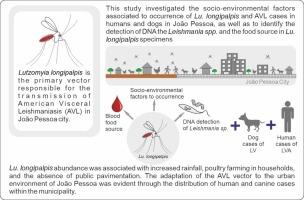巴西jo o Pessoa Paraíba与美国内脏利什曼病病媒长肢卢锥虫(双翅目:精神病科:白蛉科)发病率相关的生态流行病学因素
IF 2.2
2区 农林科学
Q2 PARASITOLOGY
引用次数: 0
摘要
约本文章由计算机程序翻译,如有差异,请以英文原文为准。

Eco-epidemiological factors associated with the incidence of Lutzomyia longipalpis (Diptera: Psychodidae: Phlebotominae), vector of American Visceral Leishmaniasis, in João Pessoa, Paraíba, Brazil
The first recorded human and canine cases of American Visceral Leishmaniasis (AVL) in the municipality of João Pessoa date back to the 1970s, coinciding with the identification of its vector, Lutzomyia longipalpis. This study aimed to investigate the socio-environmental factors associated with the occurrence of Lu. longipalpis and AVL cases in humans and dogs in João Pessoa. Additionally, it sought to detect Leishmania spp. DNA and identify the blood-feeding sources in female sand fly specimens. Light traps were placed of urban residences in João Pessoa per 21 months, and socio-environmental data on human and canine AVL cases were collected with the assistance of the Health Secretariat of the Municipality of João Pessoa. The multiplex PCR was used to detect Leishmania DNA in female Phlebotominae, and the study of the blood-feeding sources was conducted by sequencing cytochrome b gene. Human and canine AVL cases were mapped using Geographic Coordinate Reference System. A total of 1136 sand fly specimens were captured, belonging to five species: Brumptomyia brumpti, Lutzomyia longipalpis, Evandromyia (Aldamyia) evandroi, Psathyromyia (Forattiniella) brasiliensis and Sciopemyia sordellii, with Lu. longipalpis comprising 86.2 % of the specimens. Our study found that higher Lu. longipalpis abundance was associated with increased rainfall, the presence of poultry farming in households, and the absence of public pavimentation. The tests for detection of DNA of Leishmania infantum were positive for Lu. longipalpis, and the sequencing of the cytochrome b detected gene blood meals from Homo sapiens and Gallus gallus in Ev. evandroi. Moreover, the adaptation of the AVL vector to the urban environment of João Pessoa was evident through the distribution of human and canine cases across the municipality. Understanding the socio-environmental factors associated with the spread of AVL in urban areas is crucial for effective surveillance and control strategies.
求助全文
通过发布文献求助,成功后即可免费获取论文全文。
去求助
来源期刊

Veterinary parasitology
农林科学-寄生虫学
CiteScore
5.30
自引率
7.70%
发文量
126
审稿时长
36 days
期刊介绍:
The journal Veterinary Parasitology has an open access mirror journal,Veterinary Parasitology: X, sharing the same aims and scope, editorial team, submission system and rigorous peer review.
This journal is concerned with those aspects of helminthology, protozoology and entomology which are of interest to animal health investigators, veterinary practitioners and others with a special interest in parasitology. Papers of the highest quality dealing with all aspects of disease prevention, pathology, treatment, epidemiology, and control of parasites in all domesticated animals, fall within the scope of the journal. Papers of geographically limited (local) interest which are not of interest to an international audience will not be accepted. Authors who submit papers based on local data will need to indicate why their paper is relevant to a broader readership.
Parasitological studies on laboratory animals fall within the scope of the journal only if they provide a reasonably close model of a disease of domestic animals. Additionally the journal will consider papers relating to wildlife species where they may act as disease reservoirs to domestic animals, or as a zoonotic reservoir. Case studies considered to be unique or of specific interest to the journal, will also be considered on occasions at the Editors'' discretion. Papers dealing exclusively with the taxonomy of parasites do not fall within the scope of the journal.
 求助内容:
求助内容: 应助结果提醒方式:
应助结果提醒方式:


